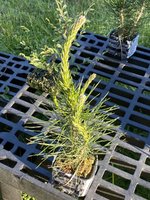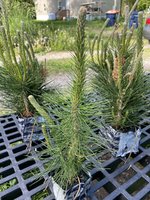You are using an out of date browser. It may not display this or other websites correctly.
You should upgrade or use an alternative browser.
You should upgrade or use an alternative browser.
ARE THESE PINE CONES ALREADY??
- Thread starter cmeg1
- Start date
namnhi
Masterpiece
I got some on the ones I bought from you last year as well. They seem to produce pollen and pine cones very early in life.
19Mateo83
Masterpiece
You must be doing something right cmeg1. I wish I had a 2 year old seedling with pine cones 
PA_Penjing
Chumono
Indeed, I have seen naturalized JBP produce pine cones at two (or maybe 3) years old. The jersey shore sand dunes never disappoint, you can take that to the bank
cmeg1
Imperial Masterpiece
They had a few mnth start indoors with the co2 and all…….would like to see some of the others do it…….some of the seedlings get a better leaf habit……..like all the way down the shoot.
would there be any merit to collecting seeds from a two or three old seedling that had very good leaf production down to the very base of the shoot or is this at a too juvenile of a state for selection?
other ones are much better in this regard such as in the pictures……needles way down to the base of shoot……others,not so much.


would there be any merit to collecting seeds from a two or three old seedling that had very good leaf production down to the very base of the shoot or is this at a too juvenile of a state for selection?
other ones are much better in this regard such as in the pictures……needles way down to the base of shoot……others,not so much.


BrightsideB
Omono
I remember reading that the health of a seedling from the start governs a lot about it’s maturation. I think you are pushing the limits on what is possible. Which is awesome!
namnhi
Masterpiece
I often heard weaker tree will flower and set fruit earlier but these are the opposite so that telling me nothing is 100% true.
cmeg1
Imperial Masterpiece
I often heard weaker tree will flower and set fruit earlier but these are the opposite so that telling me nothing is 100% true.
yea it is hard to find the real info …….especially intenet and especially if it makes another richer or if the richer man is righting the how to articles.
Wires_Guy_wires
Imperial Masterpiece
I'd say they're old enough when they enter a reproductive state. That's the onset of adult behavior.is this at a too juvenile of a state for selection?
But I have to admit I know very little of pine genetics.
If someone were to reproduce cork bark traits through seed, it would tell a lot about how JBP works in one or two generations.
20-60 seedlings from corkbark x corkbark and corkbark x wildtype/regular would suffice to figure out if there's two sets of genes (dominant and recessive) or more. If you have a cool needle type, find another of the opposite sex and try the same. I know some pines are polyploid and they can change their phenotype over time, sometimes over decades (see sports for localized examples on plants).
I haven't been able to find literature on trait selection other than limber/timber(?) and disease or pest resistance. But these have been traditional mendellian experiments that serve a good purpose. Good enough for bonsai and nurseries at least.
Hand-pollination can be a difficult one though, but I have tricks up my sleeve if anyone's interested.
I used the "just cross them and the results will tell you" trick on a couple plants. It's a fun game to play on the side and it yielded me a cool strawberry that I'm turning into a better one.
Crazy Diamond
Omono
I have seen polen cones developing in Cupressus sempervirens just 1,5 years old!! the male cones are faster and easier to produce, female cones need more nutrients
Shibui
Imperial Masterpiece
Some of my JBP produce cones at a couple of years older, some take much longer.
I think it was @River's Edge recently made comment about nutrition being responsible for reduced bare necks and needles further down the shoots.
Note that pine cones take 18 months to mature on the tree. These will ripen in fall next year. I have seen some people report viable seed from cones on potted trees but any that I've left have been empty or unviable seed.
Male cones are usually below the female cones at the tips which probably reduces pollination and may affect viability of seed in potted trees. You could try transferring pollen from the male cones to those female ones - wait for a warm day when pollen cones are opening (tap the plant to see clouds of pollen appear) and take a tree that has opened cones to those female flowers and shake to release pollen over them.
I think it was @River's Edge recently made comment about nutrition being responsible for reduced bare necks and needles further down the shoots.
Note that pine cones take 18 months to mature on the tree. These will ripen in fall next year. I have seen some people report viable seed from cones on potted trees but any that I've left have been empty or unviable seed.
Male cones are usually below the female cones at the tips which probably reduces pollination and may affect viability of seed in potted trees. You could try transferring pollen from the male cones to those female ones - wait for a warm day when pollen cones are opening (tap the plant to see clouds of pollen appear) and take a tree that has opened cones to those female flowers and shake to release pollen over them.
Daniel son STL
Shohin
Looks like pollen!
River's Edge
Masterpiece
I typically notice cone production for JBP and JRP under development in the time frame of 7-10 years. I remove them when noticed and have not left them on to check for viability. I am not a scientist but the appearance of bare necked candles it seems closely connected to high levels of nitrogen forcing extension growth. When I maintain lower levels of nutrients consistently and water the same the candles extend just as much in a slower growth pattern but have needles the full length of the candle. I do tend to use fertilizers that have all three NPK below 10 and I stick primarily to organic fertilizer.Some of my JBP produce cones at a couple of years older, some take much longer.
I think it was @River's Edge recently made comment about nutrition being responsible for reduced bare necks and needles further down the shoots.
Note that pine cones take 18 months to mature on the tree. These will ripen in fall next year. I have seen some people report viable seed from cones on potted trees but any that I've left have been empty or unviable seed.
Male cones are usually below the female cones at the tips which probably reduces pollination and may affect viability of seed in potted trees. You could try transferring pollen from the male cones to those female ones - wait for a warm day when pollen cones are opening (tap the plant to see clouds of pollen appear) and take a tree that has opened cones to those female flowers and shake to release pollen over them.
The other aspect that may affect my results is that I have a very free draining inorganic mix and it is almost impossible for me to water too much. This is very helpful for pines that like dry feet and the wet maritime winters of Vancouver Island.
Basically, I would not consider my situation comparable to the indoor set ups with controlled variables. So not sure if there is any crossover of observations.
cmeg1
Imperial Masterpiece
I am very into the slower growth effects myself……..they seem all around healthier this way and stockier.Until I see a sign like yellow leaves or something I actually keep it low Nitrogen…….less salt is more water too.I typically notice cone production for JBP and JRP under development in the time frame of 7-10 years. I remove them when noticed and have not left them on to check for viability. I am not a scientist but the appearance of bare necked candles it seems closely connected to high levels of nitrogen forcing extension growth. When I maintain lower levels of nutrients consistently and water the same the candles extend just as much in a slower growth pattern but have needles the full length of the candle. I do tend to use fertilizers that have all three NPK below 10 and I stick primarily to organic fertilizer.
The other aspect that may affect my results is that I have a very free draining inorganic mix and it is almost impossible for me to water too much. This is very helpful for pines that like dry feet and the wet maritime winters of Vancouver Island.
Basically, I would not consider my situation comparable to the indoor set ups with controlled variables. So not sure if there is any crossover of observations.
Similar threads
- Replies
- 4
- Views
- 1K

